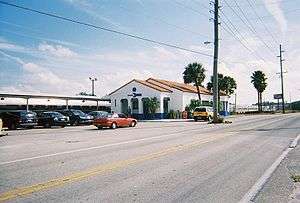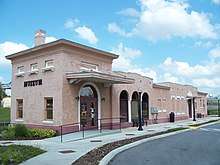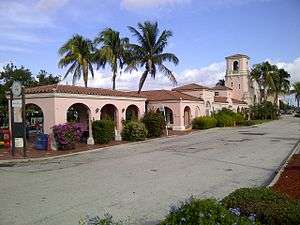Florida Western and Northern Railroad
The Florida Western and Northern Railroad was a railroad line built and operated by the Seaboard Air Line Railroad running from Coleman, Florida, (near Wildwood) all the way to West Palm Beach via Auburndale and Sebring (near Lake Okeechobee), a distance of 204 miles. Part of the line remains today from Auburndale to West Palm Beach and is now operated by CSX Transportation as their Auburndale Subdivision and Miami Subdivision.

Map of full route from Coleman to West Palm Beach | |
 Amtrak station in Sebring, which was one of the original stations built on the line to serve the Seaboard Air Line Railroad | |
| Overview | |
|---|---|
| Locale | Central Florida South Florida |
| Successor | Seaboard Air Line Railroad |
| Technical | |
| Track gauge | 4 ft 8 1⁄2 in (1,435 mm) standard gauge |
Original Route
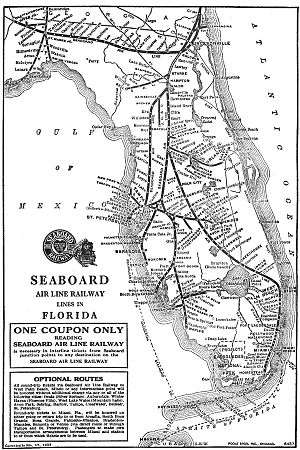
The Florida Western and Northern Railroad began in Coleman, where it branched off the Seaboard Air Line Railroad's main line (which is today the CSX S Line). It proceeded south through wetlands of north Central Florida in a nearly straight line down to Auburndale, where it crossed the Atlantic Coast Line Railroad's main line (the current CSX A Line). From here, it continued through southern Central Florida, passing through Winter Haven, West Lake Wales, Avon Park, and Sebring. Between Auburndale and Sebring, the line's trajectory closely paralleled the Atlantic Coast Line Railroad's Haines City Branch, which at one point ran from Haines City to Everglades City.
At West Lake Wales, the line crossed the Seaboard's east-west route from Plant City and Bartow to Lake Wales. The connection to this line, along with the Valrico Cutoff (which was also built in 1925), would provide for a direct cross-state route from Tampa to West Palm Beach (and later Miami).[1]
After Sebring, the line turned into a more southeast trajectory towards Okeechobee. From here, it continued southeast near the northern edge of Lake Okeechobee in a nearly straight line southeast to Indiantown and to its terminus in West Palm Beach.
History
The Seaboard Air Line Railroad first chartered the Florida Western and Northern Railroad in April 1924 and construction began shortly after. The line was beginning of Seaboard president S. Davies Warfield's ambitious plan to connect the Seaboard network to the South Florida region, which for almost thirty years had been the exclusive domain of the Florida East Coast Railway. The line's final spike was placed on January 21, 1925 and four days later, a special section of the Seaboard's Orange Blossom Special ran to West Palm Beach officially inaugurating service. President Warfield was on board with around 500 guests.[1]
The line only terminated in West Palm Beach for about a year before Seaboard organized their subsidiary Seaboard-All Florida Railway to extend it to Miami, and to Homestead and Florida City later in the decade.[2]
In 1963, the line began hosting the Atlantic Coast Line Railroad's Miami-bound passenger trains. This arrangement between Seaboard and its competitor was quickly made due to the abrupt discontinuation of passenger service on the Florida East Coast Railway, which the Atlantic Coast Line had used prior. By then, merger talks were underway between the two railroads. The merger would be complete by 1967 and the new combined company would be named the Seaboard Coast Line Railroad.[3]
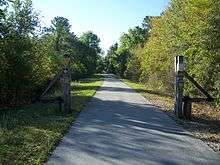
The line remained mostly unchanged through the Seaboard Coast Line era. It became their main route through southern Central Florida and segments of the Atlantic Coast Line's parallel Haines City branch were abandoned. Remaining segments of the Haines City branch became smaller branches of the Florida Western and Northern line including a short branch into Avon Park, as well as trackage now operated by the Florida Midland Railroad (Lake Wales to Frostproof) and the South Central Florida Express.[2]
In 1989, a few years after Seaboard Coast Line became CSX, the northern section of the line from Coleman to just north of Auburndale was abandoned and removed. It carried Amtrak's Miami service up until its removal, which was then shifted to its current routing along the A Line.[4] Most of the former right-of-way of the abandoned northern segment is now part of the nearly 30-mile General James A. Van Fleet State Trail, as well as the adjoining Auburndale TECO Trail.
Current operations
Today, the remaining trackage of the original Florida Western and Northern Railroad remains in service under CSX Transportation. It is now CSX's Auburndale Subdivision from its junction with the A Line in Auburndale to the control point Delta (milepost SX 956.4) near North Palm Beach County Airport. From there south, it is now the Miami Subdivision (a designation which previously continued to Miami before the line was sold to the Florida Department of Transportation from Mangonia Park south). All of Amtrak's passenger service to Miami including the Silver Meteor and Silver Star service continue to traverse the line from Auburndale to access Miami. A short spur known as McDonald Connection connects the Auburndale Subdivision with the CSX A Line towards Tampa. The Auburndale Subdivision runs in a roughly parallel trajectory to U.S. Route 27 between Avon Park and Sebring, and from Okeechobee to West Palm Beach, the line directly parallels State Road 710 which in some places known as Warfield Boulevard (named after Seaboard president S. Davies Warfield).[5][6]
Historic Station listing
References
- Turner, Gregg (2003). A Short History of Florida Railroads. Arcadia Publishing. ISBN 978-0-7385-2421-4.
- Turner, Gregg M. (2005). Florida Railroads in the 1920s. Arcadia Publishing.
- Cox, Jim (2011). Rails Across Dixie: A History of Passenger Trains in the American South. Jefferson, North Carolina: MacFarland & Company, Inc. Publishers. ISBN 978-0-7864-4528-8. Retrieved 13 November 2017.
- Spear, Kevin (20 March 1988). "Long-distance Trains Leaving Lake County Behind". Orlando Sentinel. Retrieved 28 August 2013.
- http://wiki.radioreference.com/index.php/AR-Auburndale_Sub CSX Auburndale Sub
- CSX Jacksonville Division Timetable
- Seaboard Coast Line Railroad Jacksonville Division and Tampa Division Timetable (1977)

